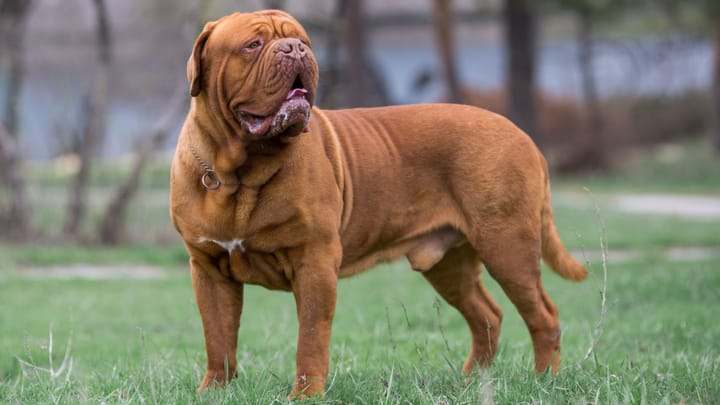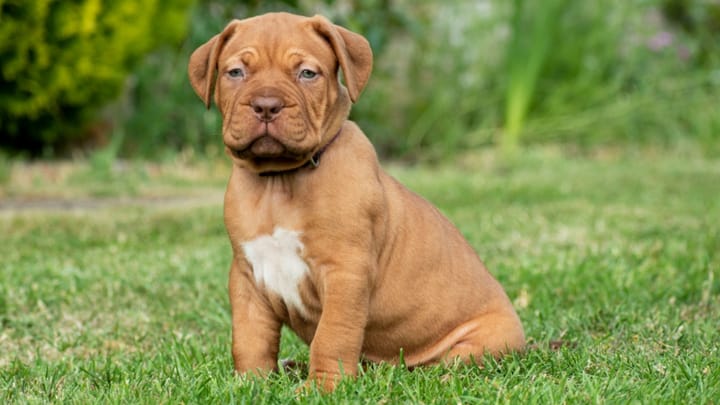Dogue de Bordeaux
Other names : Bordeaux Mastiff, French Mastiff, Bordeaux dog


The Dogue de Bordeaux is an ancient fighting dog, but has since principally been adopted for his lovely companion dog qualities and also his capacity as a watchdog. He is very close to his owners, gentle with children and protective of his social group and home grounds. Calm by nature, his expenditure needs are moderate but should nevertheless not be neglected. Available owners will bring joy to this dog who does not enjoy being left alone.
|
Life expectancy |
The Dogue de Bordeaux has a life expectancy of between 10 and 12 years |
|
Temperament |
|
|
Size |
Large
|
|
Adult size |
Female
Between 22 and 27 in
Male
Between 23 and 28 in
|
|
Adult weight |
Female
Between 99 and 110 lb
Male
Between 110 and 121 lb
|
|
Coat colour
The coat is a solid colour, ranging from mahogany to dun, always staying in the fawn tones. Otherwise, white patching is accepted around the chest- as long as it isn’t too widespread- and at the extremity of the limbs. Three varieties of mask exist: black mask, brown mask, and no mask. |
Brown |
|
Type of coat
The hair is short. The hair is fine and soft to the touch. |
Short |
|
Eye colour
The eyes are hazel to dark brown for individuals with black masks. In individuals with a brown mask or no mask, a lighter colour is admissible but not sought after. |
Brown
|
|
Purchase price |
The Dogue de Bordeaux costs between £680 and £920 |
Because of his brachycephaly (flat nose), the Dogue de Bordeaux snores and salivates a lot.
More details about the Dogue de Bordeaux
Dogue de Bordeaux: Origins and history
His origins are the same as those of other European molossians- that is to say, Asian. The first accounts we have of the Dogue de Bordeaux date back to the Middle Ages: the gothic tower of the Carcassonne church, built in the 14th century, is embellished with a dog that resembles the Dogue a lot. Written testimony speaks of a certain Aquitaine Dog, used as a hunter and watchdog and used also in fights against other animals. There were three types of Aquitaine Dogs: the Toulousain, the Parisian, and the Bordelais. The latter would have been the direct ancestor of the contemporary Dogue de Bordeaux.
Physical characteristics of the Dogue de Bordeaux
The Dogue de Bordeaux is not a giant dog, but a powerful and well built one, generally proportionate-looking, very muscular around the neck, back and limbs. The head is big, characteristic, covered in pleats, wide and rather short: seen from the front, it is trapezoidal-shaped. The skull is slightly convex; the muzzle is thick, short, square, slightly concave. The stop is abrupt. The jaws are very powerful, wide and square, and prognathic. The eyes are oval-shaped, far from one another and wide. The ears are small, with a slightly elevated base, but folded over, and of a slightly darker shade than the rest of the coat. The neck is very strong. The thorax is powerful and deep; the back is large, the kidneys short. The limbs are large. The tail, set low, doesn’t reach past the hock.
Dogue de Bordeaux: Characteristics
Dogue de Bordeaux: Behaviour
Training a Dogue de Bordeaux
Given his overpowering constitution, the Dogue de Bordeaux must be trained and socialised from his youngest age, in order to prevent any extreme behaviour from emerging later on in adulthood.
The males can be more difficult than the females but their will to please their owners and spend time with them renders training sessions pleasant and productive.
The key points to be worked on are walking on a leash without pulling (keeping in mind the dog’s strength as an adult), teaching ‘go to your spot’ to prevent any rough reactions towards guests, as well as supervised, positive, and regular encounters with his fellow dogs, in order to develop and reinforce a ‘canine code of conduct’.
Positive reinforcement should of course be put in place, but training should not under any circumstance be laxist. Firmness, diligence, and patience are key in achieving results with this dog, who tends to be difficult if all three of the latter elements are not applied.
Dogue de Bordeaux: Lifestyle
Breed compatibility Dogue de Bordeaux
Dogue de Bordeaux: Purchase price
The price of a Dogue de Bordeaux varies depending on its origins, age, and gender. You have to count an average of £920 for dogs subscribed to the Kennel Club.
With regards to the monthly budget required for this dog, it is quite significant since it wavers between £55 and £65 per month. This sum will be sufficient to meet all of the dog’s physiological needs.
Dogue de Bordeaux: Shedding
Average
Hair loss and moulting seasons are moderate with this mighty molossian. You will simply have to increase the frequency of brushes during moulting seasons, namely spring and autumn.
Dogue de Bordeaux: Grooming
The Dogue de Bordeaux’s short fur doesn’t require much maintenance. However, the pleats on his face will have to be diligently cleaned to avoid all risk of infection. Same goes for the ears and eyes.
Grooming and washing will not be necessary, unless the dog is very dirty of course. Otherwise, simple, regular brushes are sufficient to maintain the beauty and quality of his coat.
Dogue de Bordeaux: Health
Life expectancy is estimated at 11 years.
The Bordeaux dog is a dog of robust and solid constitution but is nevertheless the subject of various health problems.
As in the case of many brachycephalic dogs (flat-nosed), heat is not well tolerated. In fact, this dog cannot regulate his temperature easily, given the respiratory issues that his build causes.
It is therefore necessary to provide this dog with abundant amounts of cool water as well as a spot in the shade in times of intense heat, and to walk him early in the morning and late in the evenings.
This molossian handles the cold well, he is actually used to living outside most of the time. Beware of extreme temperatures however, as his coat remains quite thin.
If the provided nutrition is well adapted, and if snacks are not handed out excessively and the walks are regular, the Dogue de Bordeaux can maintain his intended shape without a problem.
- Hip Dysplasia
- Eye issues (entropion, ectropion, multifocal retinopathy)
- Cardiac issues (dilated myocardiopathy, aortic stenosis)
- Skin problems (hyperkeratosis of the footpads)
- Growth problems
- Epilepsy
- Arthritis







